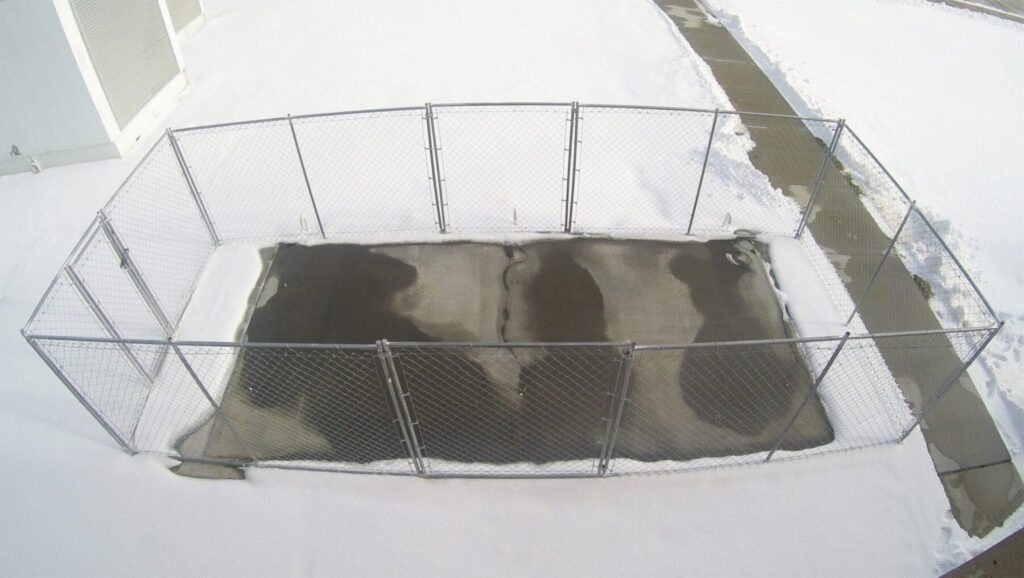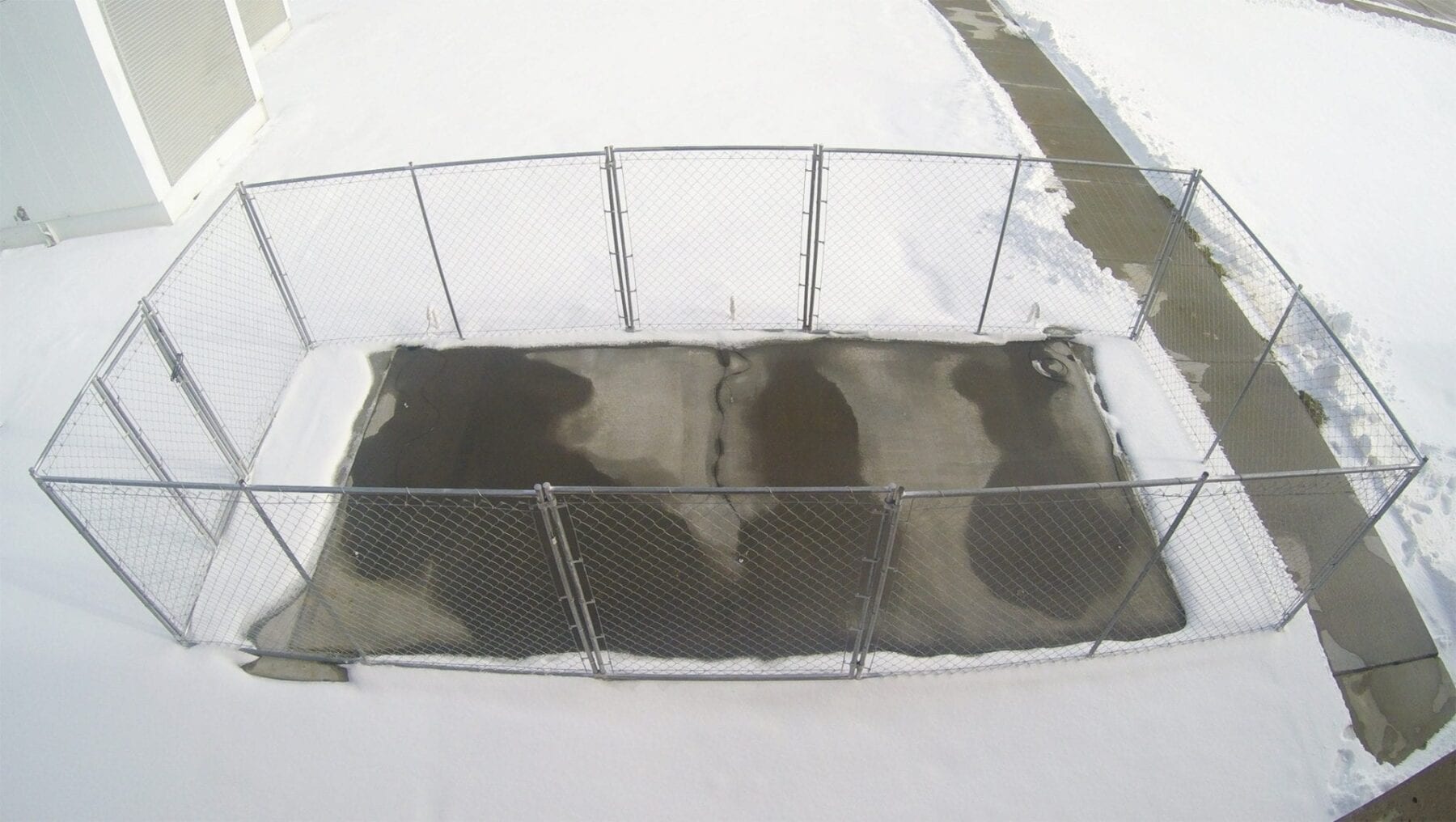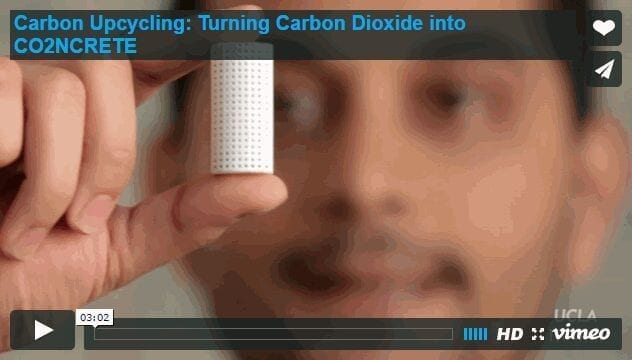
A 200-square-foot slab of seemingly ordinary concrete sits just outside the Peter Kiewit Institute as snowflakes begin parachuting toward Omaha on a frigid afternoon in late December.
The snow accumulates on the grass surrounding the slab and initially clings to the concrete, too. But as the minutes pass and the snow begins melting from only its surface, the slab reveals its secret: Like razors, stoves and guitars before it, this concrete has gone electric.
Its designer, UNL professor of civil engineering Chris Tuan, has added a pinch of steel shavings and a dash of carbon particles to a recipe that has literally been set in concrete for centuries. Though the newest ingredients constitute just 20 percent of Tuan’s otherwise standard concrete mixture, they conduct enough electricity to melt ice and snow in the worst winter storms while remaining safe to the touch.
Tuan’s research team is demonstrating the concrete’s de-icing performance to the Federal Aviation Administration during a testing phase that runs through March 2016. If the FAA is satisfied with the results, Tuan said the administration will consider scaling up the tests by integrating the technology into the tarmac of a major U.S. airport.
“To my surprise, they don’t want to use it for the runways,” Tuan said. “What they need is the tarmac around the gated areas cleared, because they have so many carts to unload — luggage service, food service, trash service, fuel service — that all need to get into those areas.
“They said that if we can heat that kind of tarmac, then there would be (far fewer) weather-related delays. We’re very optimistic.”
A unique bridge that resides about 15 miles south of Lincoln has given Tuan reason to feel confident. In 2002, Tuan and the Nebraska Department of Roads made the 150-foot Roca Spur Bridge the world’s first to incorporate conductive concrete. Inlaid with 52 conductive slabs that have successfully de-iced its surface for more than a decade, the bridge exemplifies the sort of targeted site that Tuan envisions for the technology.
“Bridges always freeze up first, because they’re exposed to the elements on top and bottom,” Tuan said. “It’s not cost-effective to build entire roadways using conductive concrete, but you can use it at certain locations where you always get ice or have potholes.”
Potholes often originate from the liberal use of salt or de-icing chemicals that can corrode concrete and contaminate groundwater over time, Tuan said, making the conductive concrete an appealing alternative with lower operating and maintenance costs. The power required to thermally de-ice the Roca Spur Bridge during a three-day storm typically costs about $250 — several times less than a truckload of chemicals, he said.
Tuan said the conductive concrete could also prove feasible for high-traffic intersections, exit ramps, driveways and sidewalks. Yet the technology offers another, very different application that doesn’t even require electric current.
Catching the next wave
By replacing the limestone and sand typically used in concrete with a mineral called magnetite, Tuan has shown that the mixture can also shield against electromagnetic waves. The electromagnetic spectrum includes the radiofrequency waves transmitted and received by cellphones, which Tuan said could make the concrete mixture useful to those concerned about becoming targets of industrial espionage.
Using the magnetite-embedded concrete, Tuan and his colleagues have built a small structure in their laboratory that demonstrates the material’s shielding capabilities.
“We invite parties that are interested in the technology to go in there and try to use their cellphones,” said Tuan, who has patented his design through NUtech Ventures. “And they always receive a no-service message.”
While Tuan’s collaborations have him dreaming big about the future of conductive concrete, he’s currently enjoying its benefits much closer to home.
“I have a patio in my backyard that is made of conductive concrete,” he said with a laugh. “So I’m practicing what I preach.”
Read more: De-icing concrete could improve roadway safety, guard against corporate espionage
The Latest on: Conductive concrete
[google_news title=”” keyword=”conductive concrete” num_posts=”10″ blurb_length=”0″ show_thumb=”left”]
via Google News
The Latest on: Conductive concrete
- MIT Conductive Concrete Consortium Secures Five-Year Research Agreement with Japanese Industryon May 3, 2024 at 6:02 pm
The MIT Electron-conductive Cement-based Materials Hub (EC^3 Hub), an outgrowth of the MIT Concrete Sustainability Hub (CSHub), has been established by a five-year sponsored research agreement with ...
- Learn About The Pros And Cons Of Concrete Countertopson April 22, 2024 at 6:04 pm
Concrete countertops have seen an uptick in popularity recently but it can remain a divisive subject. Concrete countertops have a ton of versatility and can create unique looks, but others see it ...
- Buying a House on a Concrete Slab: Advantages and Disadvantageson April 19, 2024 at 11:20 pm
Pros and Cons of Buying a House on a Concrete Slab Mark Cussen, CMFC, has 13+ years of experience as a writer and provides financial education to military service members and the public.
- Concrete Blocks in Architecture: How to Build With This Modular and Low-Cost Materialon April 8, 2024 at 5:00 pm
Concrete blocks are prefabricated materials primarily used for constructing walls. Similar to bricks, these blocks are stacked together and bonded with mortar, typically composed of cement, sand ...
- Rechargeable concrete batteries could make buildings double as energy storageon March 21, 2024 at 1:28 pm
Civil engineers at the university found a way to integrate electrically conductive fibers into a cement-based mixture. With this innovation, they could turn concrete slabs into batteries.
- Concrete Blocks: The Latest Architecture and Newson February 6, 2024 at 4:00 pm
They continued to replicate outdated models, showcasing a lack of progress in the sector. Concrete blocks are prefabricated materials primarily used for constructing walls. Similar to bricks ...
- MIT Cracks The Concrete Capacitoron August 2, 2023 at 2:48 am
By introducing electrically conductive carbon black to the mix and using potassium chloride solution instead of water, they turn the huge surface area of the resulting structure into a conductive ...
- How much do polished concrete floors cost?on February 16, 2023 at 7:59 am
He is married to Diane, and they have 3 kids and 2 grandkids. Polished concrete flooring creates a clean contemporary look while offering enough versatility to create a unique design statement.
- Concrete Riveron July 25, 2022 at 5:00 pm
A dead bird lies on the slanted pavement, its neck twisted in the shape of an ‘S’. In the distance, a lone man makes his way across a slippery concrete riverbed, now coated in algae. Occasionally, a ...
- Ground Enhancement Materials (GEM) Informationon February 11, 2018 at 6:58 am
conductive concrete, conductive cement, grounding fills, and chemical earthing. Electrical grounding is required to supply a ground for an electrical distribution system or to dissipate electrical ...
via Bing News











